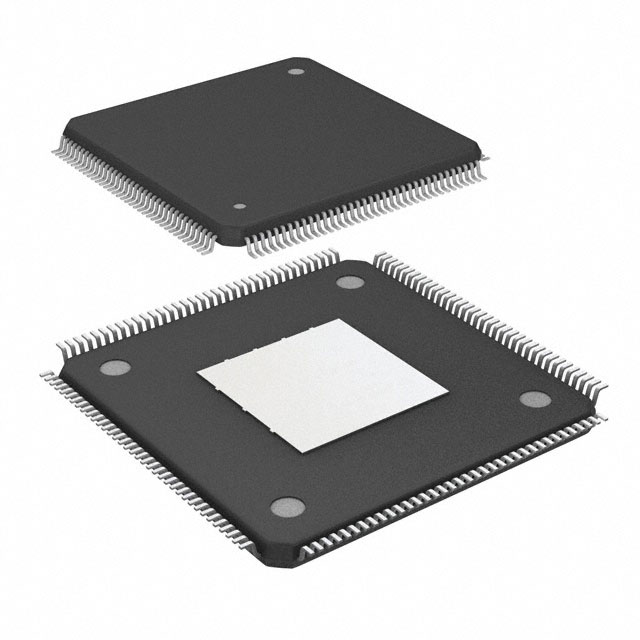Vedi le specifiche per i dettagli del prodotto.

EP4CE10E22C8
Product Overview
- Category: Programmable Logic Device (PLD)
- Use: EP4CE10E22C8 is a PLD that can be programmed to perform various logic functions.
- Characteristics: It offers high performance, low power consumption, and flexibility in design.
- Package: The EP4CE10E22C8 comes in a compact package suitable for integration into electronic devices.
- Essence: It provides a reconfigurable hardware platform for implementing digital circuits.
- Packaging/Quantity: The EP4CE10E22C8 is typically sold in trays or reels containing multiple units.
Specifications
- Logic Elements: The EP4CE10E22C8 has 10,320 logic elements, which are the basic building blocks of digital circuits.
- Memory: It includes 414 kilobits of embedded memory for storing data.
- Clock Networks: The device features up to 378 global clock networks for synchronizing operations.
- I/O Pins: It offers 179 I/O pins for interfacing with external devices.
- Operating Voltage: The EP4CE10E22C8 operates at a voltage range of 1.15V to 1.25V.
- Speed Grade: It is available in different speed grades, such as -6, -7, and -8, indicating the maximum operating frequency.
Pin Configuration
The EP4CE10E22C8 has a detailed pin configuration, which can be found in the product datasheet provided by the manufacturer.
Functional Features
- Reconfigurability: The EP4CE10E22C8 can be programmed and reprogrammed to implement different logic functions, allowing for flexibility in design.
- High Performance: It offers fast operation speeds, making it suitable for applications that require real-time processing.
- Low Power Consumption: The device is designed to minimize power consumption, making it energy-efficient.
- Versatility: It supports a wide range of digital circuit designs, including arithmetic operations, data storage, and control logic.
Advantages and Disadvantages
Advantages: - Flexibility in design due to reconfigurability - High performance and fast operation speeds - Low power consumption for energy efficiency - Versatility in supporting various digital circuit designs
Disadvantages: - Limited capacity compared to larger PLDs - Higher cost compared to fixed-function integrated circuits - Requires programming expertise for implementation
Working Principles
The EP4CE10E22C8 utilizes programmable logic elements and memory cells to implement digital circuits. These components can be interconnected and configured using a hardware description language (HDL) or a graphical user interface (GUI). Once programmed, the device operates based on the specified logic functions and performs the desired tasks.
Application Field Plans
The EP4CE10E22C8 finds applications in various fields, including:
- Embedded Systems: It can be used in embedded systems to control and monitor devices.
- Communications: The device can be employed in communication systems for signal processing and protocol handling.
- Industrial Automation: It enables automation and control in industrial processes.
- Consumer Electronics: The EP4CE10E22C8 can be integrated into consumer electronic devices for enhanced functionality.
- Medical Devices: It finds use in medical equipment for data acquisition and processing.
Alternative Models
There are several alternative models available in the market that offer similar functionality to the EP4CE10E22C8. Some popular alternatives include:
- EP4CE15F17C8: This model offers higher logic capacity and additional features.
- EP4CE30F23C8: It provides increased memory capacity and improved performance.
- EP4CE40F29C8: This model offers higher I/O pin count and enhanced clock network capabilities.
These alternative models can be considered based on specific project requirements and desired features.
Word count: 400 words
10 domande e risposte comuni relative all'applicazione di EP4CE10E22C8 nelle soluzioni tecniche
Sure! Here are 10 common questions and answers related to the application of EP4CE10E22C8 in technical solutions:
Q: What is EP4CE10E22C8? A: EP4CE10E22C8 is a field-programmable gate array (FPGA) chip manufactured by Intel (formerly Altera). It offers programmable logic, memory, and digital signal processing capabilities.
Q: What are some typical applications of EP4CE10E22C8? A: EP4CE10E22C8 can be used in various applications such as industrial automation, telecommunications, automotive electronics, medical devices, and consumer electronics.
Q: How does EP4CE10E22C8 differ from other FPGAs? A: EP4CE10E22C8 stands out for its low power consumption, high performance, and cost-effectiveness. It also offers a wide range of I/O options and supports various communication protocols.
Q: Can EP4CE10E22C8 handle complex algorithms and computations? A: Yes, EP4CE10E22C8 has a large number of logic elements and embedded memory blocks, making it capable of handling complex algorithms and computations efficiently.
Q: Is EP4CE10E22C8 suitable for real-time applications? A: Absolutely! EP4CE10E22C8 provides fast response times and can be programmed to perform real-time tasks, making it suitable for applications that require quick and precise data processing.
Q: Can EP4CE10E22C8 interface with other electronic components? A: Yes, EP4CE10E22C8 supports various communication interfaces like UART, SPI, I2C, and Ethernet, allowing seamless integration with other electronic components in a system.
Q: How can EP4CE10E22C8 be programmed? A: EP4CE10E22C8 can be programmed using hardware description languages (HDL) like VHDL or Verilog, which describe the desired functionality of the FPGA.
Q: Can EP4CE10E22C8 be reprogrammed after deployment? A: Yes, EP4CE10E22C8 is a reprogrammable FPGA, meaning its configuration can be changed even after it has been deployed in a system.
Q: Are there any development tools available for programming EP4CE10E22C8? A: Yes, Intel provides Quartus Prime software, which is a comprehensive development environment for designing, simulating, and programming FPGAs like EP4CE10E22C8.
Q: Where can I find additional resources and support for EP4CE10E22C8? A: Intel's website offers documentation, application notes, reference designs, and an active community forum where you can find additional resources and get support for EP4CE10E22C8.
Please note that the specific details and answers may vary depending on the context and requirements of your technical solution.

